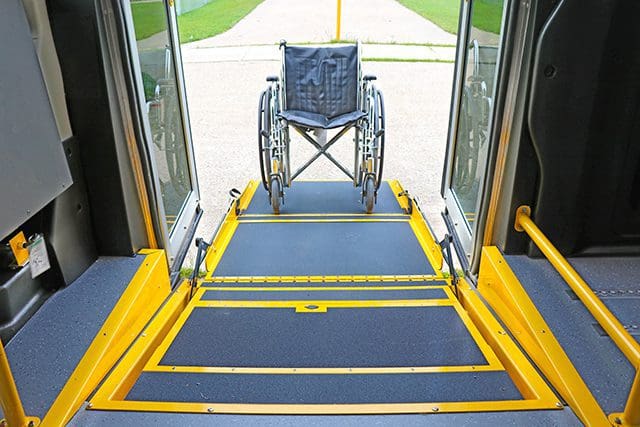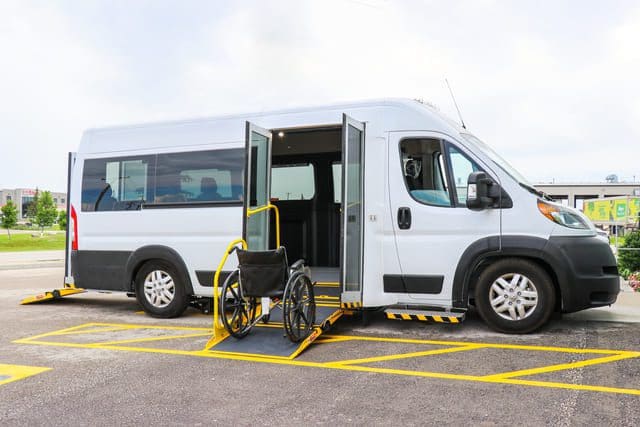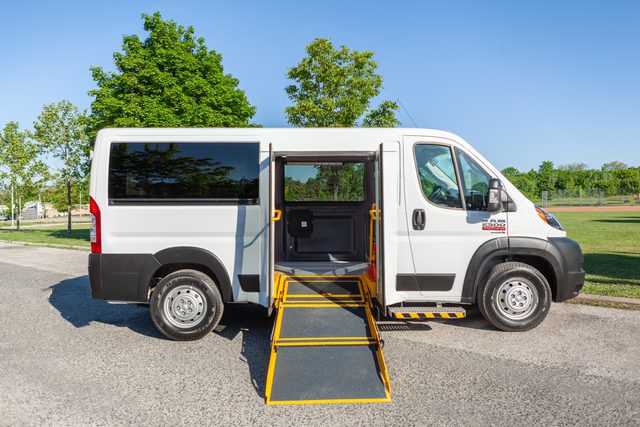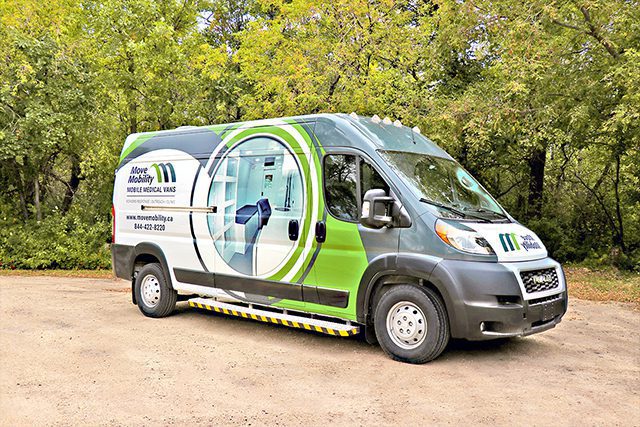Is your organization wondering how to reduce the ramp angle on wheelchair van ramps? Some of the potential problems that can occur with a higher ramp angle are:
- Accessibility difficulty
- Safety concerns
- Limited usability
- Increased wear and tear
At MoveMobility, we manufacture state-of-the-art, wheelchair accessible vans for organizations that are focused on making healthcare accessible to all. Accessibility and safety are at the backbone of everything we do, and that’s why we’re giving you some ways to reduce the ramp angle for wheelchair vans.
In this article, you’ll learn:
- Why a steep ramp angle is a concern for wheelchair users
- Some of the challenges faced by people using wheelchair vans with a steep ramp
- Five effective ways to address reduce the ramp angle for wheelchair vans
6 Challenges of steep angles on wheelchair van ramps
When wheelchair users encounter steep ramp angles, it can create several challenges for their safety and comfort. An angle of around 5 to 7 degrees is considered reasonable for ease of use. Beyond that, it starts to get a little too steep. Let’s take a look at why this is a concern and what possible impacts it can have.
- Slippery and hazardous: Steep ramps can be risky if they’re slippery. This can make it hard for wheelchair users to stay in control while going down the ramp. The potential for slipping can lead to accidents and injuries, causing distress and discomfort for your clients.
- Controlling speed: Going down a steep ramp can be tricky for wheelchair users because they might struggle to control their speed of descent. Without proper control, they might end up moving too fast, which can be scary and even dangerous.
- Intimidation: Steep ramp angles might intimidate your clients who use your organization’s wheelchair accessible van. This can discourage them from seeking assistance and limit their travel options.
- Ascent and traction: Wheelchair users can feel uneasy when going up steep ramps, especially if the surface doesn’t provide good traction. Poor ramp traction can make the wheels of the wheelchair slip, making the ascent difficult and potentially unsafe.
- Instability: If a wheelchair user sits high in their wheelchair, a steep ramp can make them feel like they’re about to tip over. This feeling of instability can cause fear and discomfort, making them hesitant to use the ramp.
- Challenging for staff members: Steep ramps can also make it challenging for staff members, particularly those who are smaller, to push heavy wheelchairs. This can further complicate the process of assisting passengers with mobility needs.
Wheelchair users deserve to feel safe and comfortable when using ramps in your organization’s wheelchair accessible van. Steep angles can compromise both of these important aspects.
It’s important to ensure that ramps are designed with user safety and comfort in mind, to make mobility easier and more enjoyable for everyone.
How do you reduce the angle for wheelchair van ramps?
There are 5 effective ways to reduce the ramp angle for wheelchair vans.
1. Mention your concerns
When you’re in the market for a wheelchair van and are worried about the ramp angle, make sure to bring that up with your account executive. They’ll guide you to the right van options that work for your organization’s specific needs.
For wheelchair accessible minivans, one effective way to reduce the ramp angle is to lower the floor of the van. When the floor of the vehicle is lowered, the ramp isn’t as steep. So, when your clients in wheelchairs use the ramp to get in or out of the van, they won’t feel as intimidated by the incline. This makes things safer and easier for them.
2. Get a vehicle with a kneeling system
To tackle the challenges posed by steep ramps for wheelchair users, another effective solution is to get a vehicle equipped with a kneeling system. This innovative feature allows the van to lower itself closer to the ground during the boarding and exiting process. It’s like the van bows down slightly to offer better accessibility for not only your passengers but also your drivers.
If you’re interested in getting a kneeling system in your wheelchair accessible van, make sure to mention this to your account executive.
3. Unload onto a curb or sidewalk

Another practical solution is to consider unloading onto a curb or sidewalk. This approach involves using the existing infrastructure to create a smoother transition for individuals using wheelchairs.
Instead of relying solely on ramps, unloading onto a curb or sidewalk can provide a more level surface for wheelchair users to move on. All your wheelchair van driver has to do is align the van with a curb or sidewalk when they park. The difference in height between the vehicle and the ground is minimized, creating a safer and more accessible exit for your clients in wheelchairs.
This method virtually eliminates the need for a ramp, resulting in a near-flat transition for wheelchair users to enter or exit the van. With a lower height difference, the risk of accidents or discomfort due to steep ramps is greatly reduced.
While unloading onto a curb or sidewalk is an easy solution, there are two things to consider:
Accessibility of location: It’s important to ensure that the chosen curb or sidewalk is accessible and safe for wheelchair users.
Consistency: This approach might not be feasible in all locations, so it’s helpful to have alternatives available to accommodate different situations.
4. Get a winch system to assist with unloading
Another effective strategy is using a winch system to help your clients in wheelchairs unload from the wheelchair van. A winch system is a mechanical device that uses a motor and winding drum to pull the wheelchair. A winch in a wheelchair van can help guide a wheelchair up or down a ramp.
The nice thing about a winch system is how controlled it is. With a winch system, your clients will experience a safer and smoother transition from the wheelchair van. In addition, much less physical effort is required to navigate ramps with a winch system. They offer more precise control, and this can help prevent accidents and discomfort related to steep ramps.
There are some considerations to keep in mind when deciding on a winch system. An integrated winch system involves additional expenses, including:
- Cost of the winch
- Installation
- Modifications to the van
A winch system also results in an extended loading and unloading time because the wheelchair needs to be secured before use.
5. Choose parking locations with level ground

The last solution to reducing the ramp angle for wheelchair vans is choosing parking locations with level ground. When you choose a parking spot with a more even surface, loading and unloading your clients is much easier.
Parking on level ground reduces the incline of the ramp. This makes it much safer and more straightforward for your clients to move in and out of the van.
Are there regulations on wheelchair van ramps?
To make sure that wheelchair vans are accessible and safe, there are regulations that state how steep the ramp can be. These guidelines help wheelchair van manufacturers create ramps that work safely and well for everyone.
One rule says that the ramp angle must be a minimum of 4:1. That might sound a bit complicated, but it just means that for every 4 units of horizontal distance along the ground, the height of the ramp should include 1 unit of vertical rise. In real terms, this means if you experience one foot of drop from the van to the ground, the ramp will need to be four feet long.
Going beyond the code
At MoveMobility, we go beyond the code for the best safety measures possible. Our ramps are between 5:1 and 6:1, which is even less steep than the code requires. When the ramp is less steep, it becomes even more comfortable and secure for wheelchair users to get in and out of the van.
Read our article on the legal requirements for transporting wheelchairs if you’re interested in more information on some of the regulations.
Easing steep ramp angles: van modifications for accessibility
Sometimes, the way the ramp is placed on the van can make a big difference in how easy it is for people using wheelchairs to get in and out. If the ramp is put at the side of the van, there can be some challenges involved. Let’s see how adjusting the ramp placement can help.
Side entrance ramps
Side entrance ramps can sometimes be a bit more difficult to access for the larger wheelchairs. When you reach the top of the ramp, the wheelchair needs to be turned at a 90° angle and faced forward.
If the ramp is placed at the back of the van instead of the side, this issue can be resolved because the wheelchair is already facing forward.
Maintaining your wheelchair van ramp
Just like any other piece of equipment, wheelchair ramps on vans need some care and attention to work well over time. Regular maintenance and inspections are like giving the ramp a check-up to make sure it’s still safe and accessible.
Here’s why this matters:
Preventing issues with regular checks: If you had a bike that you never checked for loose screws or flat tires – it might not work very well after a while. The same goes for wheelchair ramps. Over time, things can wear out or get damaged, and that can affect how well the ramp works. Regular inspections help catch these issues before they become big problems.
Maintenance practices: One important part of maintenance is keeping the ramp clean. This might sound simple, but it’s super important. Dirt, debris, or even leaves can make the ramp surface slippery, and that’s not safe for your clients.
Also, ramps often have grip tape to provide traction, and this tape can wear out or peel over time. Regular cleaning and making sure the grip tape is intact can prevent slips and make sure your clients can use the ramp safely.
What’s next?

You made it to this article while trying to learn more about how to reduce the ramp angle for wheelchair vans to ensure the safety of your clients.
For over a decade, our dedicated team at MoveMobility has been manufacturing wheelchair vans with safety as the utmost priority. We go beyond standard ramp rules and regulations so that our ramps offer accessibility that surpasses expectations, guaranteeing your clients a secure and comfortable mobility experience.
If you’re in the market for a wheelchair, there are some important articles you should look through. To start with, learn more about how to choose a wheelchair van for your organization.
If your organization is still trying to navigate funding for your wheelchair van, take a look through our article on grants for wheelchair vans.
Also, for organizations experiencing confusion about purchasing a wheelchair van, read this article on how to buy a wheelchair van.







